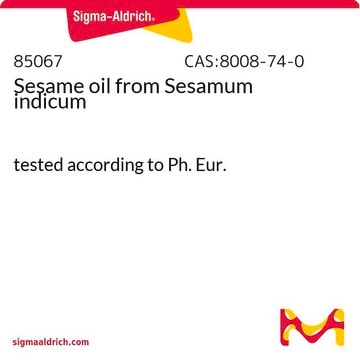88597
Peroxyde d'hydrogène solution
3%, suitable for microbiology
Synonyme(s) :
Catalase Test, Catalase Test, H2O2
About This Item
Produits recommandés
Agence
according to GB 4789.30-2016
according to ISO 10272-1:2017
according to ISO 10272-2:2017
according to ISO 11290-1:2017
according to ISO 11290-2:2017
Niveau de qualité
Pression de vapeur
23.3 mmHg ( 30 °C)
Pureté
2.8-3.2% (redox titration)
Forme
solution
Durée de conservation
limited shelf life, expiry date on the label
Conditions de stockage
protect from light
Concentration
1-5%
Technique(s)
microbe id | specific enzyme detection: suitable
Couleur
colorless
pH
6-8 (25 °C)
Pf
0.0 °C
Densité
1.000 g/cm3
Application(s)
clinical testing
environmental
food and beverages
veterinary
microbiology
Adéquation
Pneumococcus spp.
Staphylococcus spp.
bacteria
Chaîne SMILES
OO
InChI
1S/H2O2/c1-2/h1-2H
Clé InChI
MHAJPDPJQMAIIY-UHFFFAOYSA-N
Vous recherchez des produits similaires ? Visite Guide de comparaison des produits
Description générale
Application
- Disinfectant: Hydrogen peroxide can be used as a disinfectant for surfaces, materials, and equipment in microbiology labs. When applied to surfaces, hydrogen peroxide reacts with organic materials, such as bacteria and fungi, and destroys them through oxidation.
- Sterilization: Hydrogen peroxide is often used in sterilization procedures in microbiology, especially in the pharmaceutical and medical industries. It effectively kills spores that are resistant to many other types of disinfectants.
- Microbial detection: Hydrogen peroxide can be used to detect catalase activity in bacteria, making it useful in microbial identification and differentiation. The species of bacteria may be distinguished based on their ability to catalyze the breakdown of hydrogen peroxide.
Code de la classe de stockage
12 - Non Combustible Liquids
Classe de danger pour l'eau (WGK)
WGK 1
Point d'éclair (°F)
Not applicable
Point d'éclair (°C)
Not applicable
Équipement de protection individuelle
Faceshields, Gloves, Goggles
Choose from one of the most recent versions:
Déjà en possession de ce produit ?
Retrouvez la documentation relative aux produits que vous avez récemment achetés dans la Bibliothèque de documents.
Les clients ont également consulté
Articles
There are many other methods of detection to indicate the presence of E. coli. Review common tests and biochemical reactions for this contaminant.
Specific agars and broths support detection and cultivation of Campylobacter, requiring complex media with essential supplements.
Chromogenic media enable the selective detection of S. aureus, which produce bluish-green colonies that are clearly differentiated from other species.
For microbiologists the most fundamental stain was developed in 1884 by the Danish bacteriologist Hans Christian Gram.
Protocoles
Listeria is a public health concern, affecting elderly, pregnant, newborns, and immunocompromised individuals.
Notre équipe de scientifiques dispose d'une expérience dans tous les secteurs de la recherche, notamment en sciences de la vie, science des matériaux, synthèse chimique, chromatographie, analyse et dans de nombreux autres domaines..
Contacter notre Service technique
